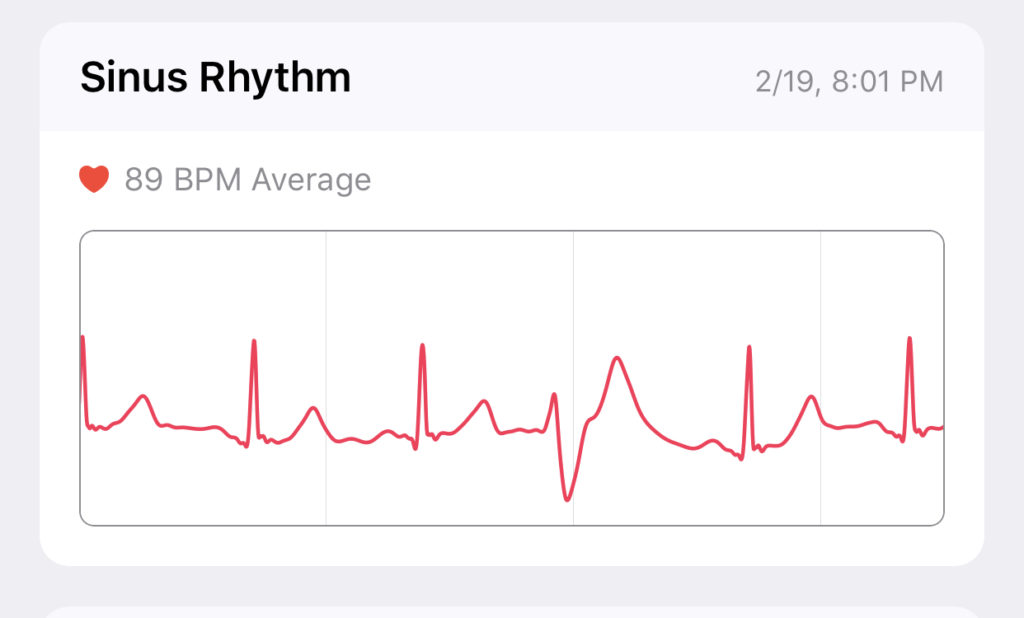My wife and I had an adventure with the Apple Watch’s ECG when my wife started to experience some large dips in her ecg.
Some of you might have noticed that I didn’t update the site at all last week. That would mark the first time the site had gone that long without an update since I really started this thing.
I had a lot of irons in the fire, so to speak.
Setting the Scene
The craziest of all of it was Tuesday night. It started just like any other day around Houston – it rained again. I’m starting to think that Houston has been transported to the Pacific Northwest. It’s rained so much.
That night, I started dinner so that when my wife got home from her workout, we would be able to sit down and eat. Fortunately for me, my wife got home before I got done with the cooking. So we helped each other finish getting everything ready while we got to talk about our days. Unbeknownst to me, she had been feeling mild heart palpitations.
I can’t say that I’ve ever had a heart palpitation. I don’t know what it feels like. On the other hand, she thought that everyone had them and that it wasn’t a big deal.
As we sat down to dinner, those heart palpitations started to come more frequently. Since I hadn’t ever experienced one, I wasn’t sure how serious to really take it. At first, she seemed okay with it, but when the third one hit her while we sat for only a few minutes, panic started to take over in both of us.
Apple Watch’s ECG to the Rescue
Once the fourth one hit, I took my series 4 Apple Watch and put it on her wrist. She had actually worn an Apple Watch since the original came out until just that weekend before when hers fell to the floor, shattering the screen.

Even if she had her watch, she wouldn’t have been able to do what I was trying to do. I turned the Apple Watch’s ECG app on, and we monitored her heart. Sure enough, we could see large dips in the ECG every few minutes.

We are fortunate enough to also have a few doctor friends; many of those are heart focused since she is an echocardiographer (if that interests you, follow her on Instagram!).
Unfortunately for us, no one answered.
We finally decided that we needed to go to an Urgent Care facility, so we packed up and left.
On the way to Urgent Care, one of our doctor friends finally got back to us and said that she might be dehydrated, so she should drink Gatorade and eat a banana. So I pulled us over and ran (literally) into a Wal-Mart. Her palpitations were also starting to come closer together. She continued to use the Apple Watch’s ECG to monitor her heart rate.
We got to the Urgent Care, filled out the forms, and waited. Meanwhile, she continued to monitor her heart on the Watch and drink her energy drinks.
The Doctor Wasn’t Impressed
Finally, about five minutes before the doctor was able to see us, everything was back to normal. We still ran another ECG to check. It came back to normal.
The Doctor recognized that there were palpitations but didn’t think the technology was as cool as we did. He told us his brother in New York deals with people that come in all the time because the Watch says that they have a problem when they don’t really. Still, he said that he did see what was happening.
Wrapping It All Up
There have been many amazing stories about how the Apple Watch has saved lives. It is a fantastic device and something that I think will leave a lasting impact on history as our devices start to monitor us (in a good way?) more. I also feel very fortunate that our case wasn’t as dangerous as some published. Apple has done so much in the health space to save lives, from adding things like the ECG to simple stuff like Medical IDs on your iPhone and Apple Watch.
Still, I was very happy to have the data and to see what was going on with my wife’s heart. If you’re thinking of getting an Apple Watch, I highly recommend it. Now, more than ever, I would probably recommend the Series 4 over everything else out there.
Stay safe, everyone.
The Apple Watch has been a great health analyzer since it came out. See what the watchOS 10 redesign is going to bring to the wrist-worn device.
Discover more from JSwordSmith
Subscribe to get the latest posts sent to your email.
